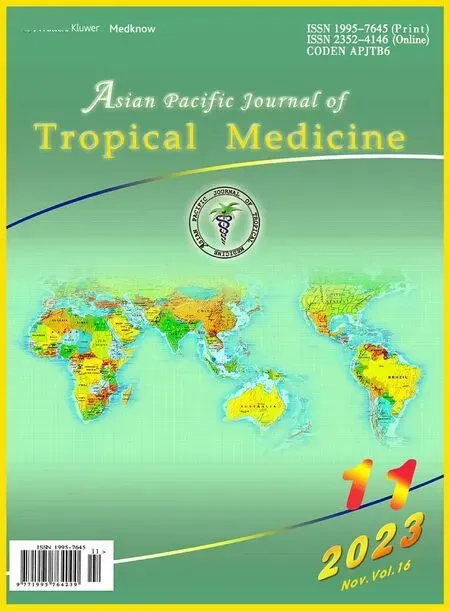Elimination of lymphatic filariasis-Challenging but not impossible
2023-04-23LakshmiKrishnasamy
Lakshmi Krishnasamy
Professor of Microbiology,Sree Balaji Medical College and Hospital,Bharath Institute of Higher Education and Research,Chennai,Tamilnadu,India
We recently went through your article titled “Elimination of lymphatic filariasis: Where do we stand so far?” by Aashna Sinhaet al[1].The authors have brought about relevant information regarding lymphatic filariasis focussing on history,diagnostic aspects,treatment strategies and various control measures.Lymphatic filariasis is a neglected parasitic infection affecting millions of people worldwide.Diethyl carbamazine (DEC) and albendazole are the frequently used drugs of choice for treating the adult worms and microfilariae.The triple drug therapy (ivermectin along with DEC and albendazole) namely the IDA has also been described upon.
This article has been an eye-opener for us in the control and prevention aspects of lymphatic filariasis.The authors have described the various approaches towards control of this parasitic infection.Though the Indian government has taken extensive measures like initiating mass drug administration programmes in endemic regions,expanding hydrocelectomies in hospitals,the triple drug therapy implementation programmes in India is still facing several challenges in the elimination of lymphatic filariasis.
This article makes us to think in the context of looking outside the box.In spite of so many control measures being taken,we are not in a position to eliminate this parasitic infection.Is it the development of resistance to the mass drug administration or the possibility of coinfections complicating the treatment of the disease,or the patient’s fear of side effects of the drugs,what is still preventing us from achieving our goal of elimination?
Mass drug administration and vector control are the two principal strategies to eliminate this infectious disease.Poor knowledge about lymphatic filariasis and the social stigma associated with the complications of the disease stand as barriers and may delay the identification and treatment of the infection.However,many countries have successfully eliminated the illness and it is not an impossible task for the rest of the world.
As rightly said by the authors,increased awareness,improved diagnostic measures,integrated approaches,continued efforts and funding for research will definitely pave way for accomplishing the elimination target.Lymphatic filariasis has now been eliminated from 17 countries[2,3].The National Health Policy (2002) has set the goal of elimination of lymphatic filariasis in India by 2015,later extended to 2021.The goal set by the global program to eliminate lymphatic filariasis was to eliminate lymphatic filariasis by 2020.The global goal was subsequently revised to eliminate lymphatic filariasis by 2030[3,4].To achieve this target through Sustainable Development Goal-3,more than 65% of the population need to be covered by and compliant to mass drug administration[5,6].
Lymphatic filariasis a relatively a major issue in a resource-limited setting.Poor hygiene,lack of awareness and limited access to the healthcare setting makes it difficult to implement effective infection control practices especially in endemic regions.Appropriate funding and budget allocation,microplanning,effective training,engaging the social media,proper monitoring,reviewing and constant evaluation of the progress status would help in the success of the elimination of lymphatic filariasis in future.Elimination of lymphatic filariasis is hard,but not impossible if we work unitedly.
Conflict of interest statement
The author declares that there is no conflict of interest.
Funding
The author received no extramural funding for the study.
杂志排行
Asian Pacific Journal of Tropical Medicine的其它文章
- Myocarditis in scrub typhus-An uncommon presentation
- Association between the Lung Immune Prognostic Index and mortality in patients with idiopathic inflammatory myopathy-associated interstitial lung disease
- Mycobacterium tuberculosis infection among children under fifteen years of age: A population-based study in Indonesia
- Disease burden,antimicrobial resistance and molecular characterization of invasive group B Streptococcus among non-pregnant adults in Malaysia: A protocol study
- Glycolysis and acute lung injury: A review
- Applications of nanomaterials in mosquito vector control: A review
